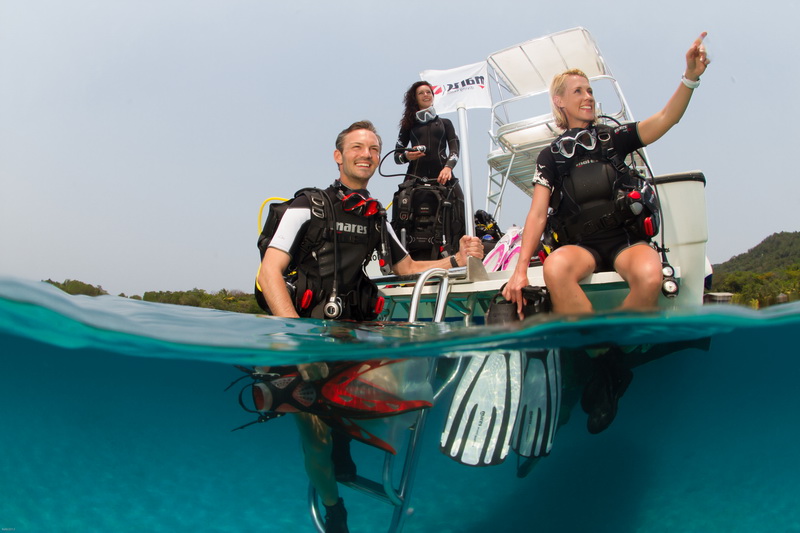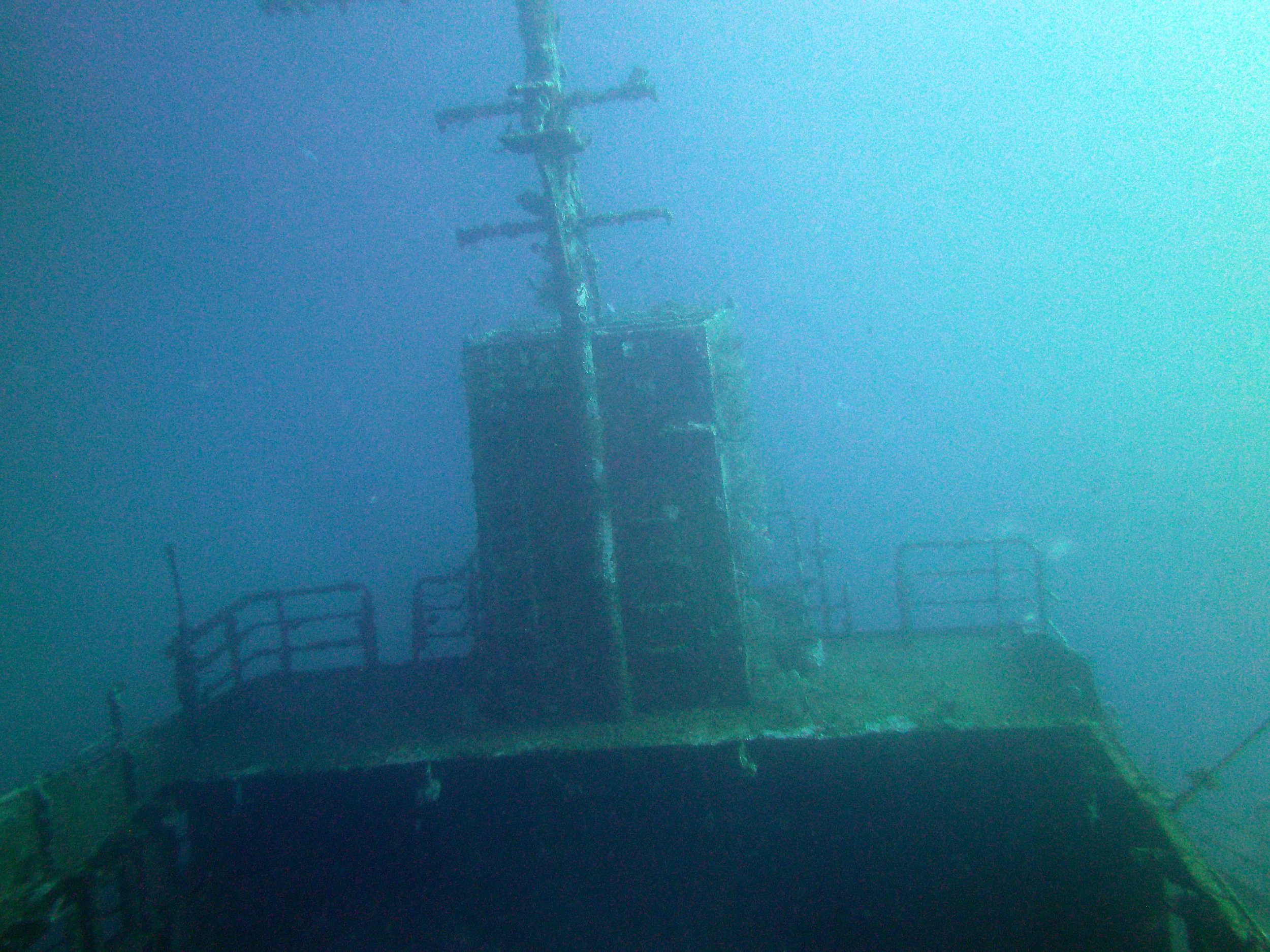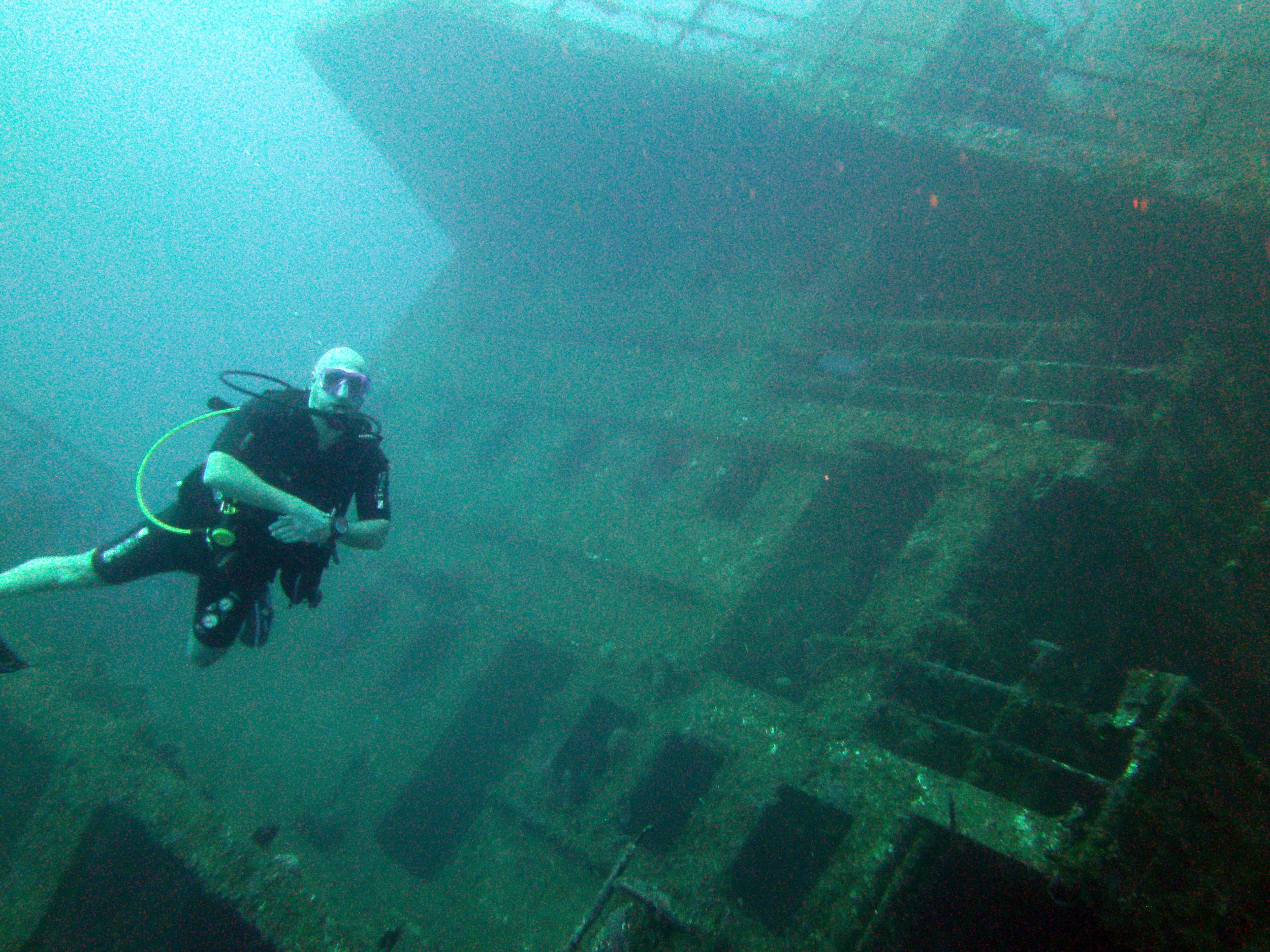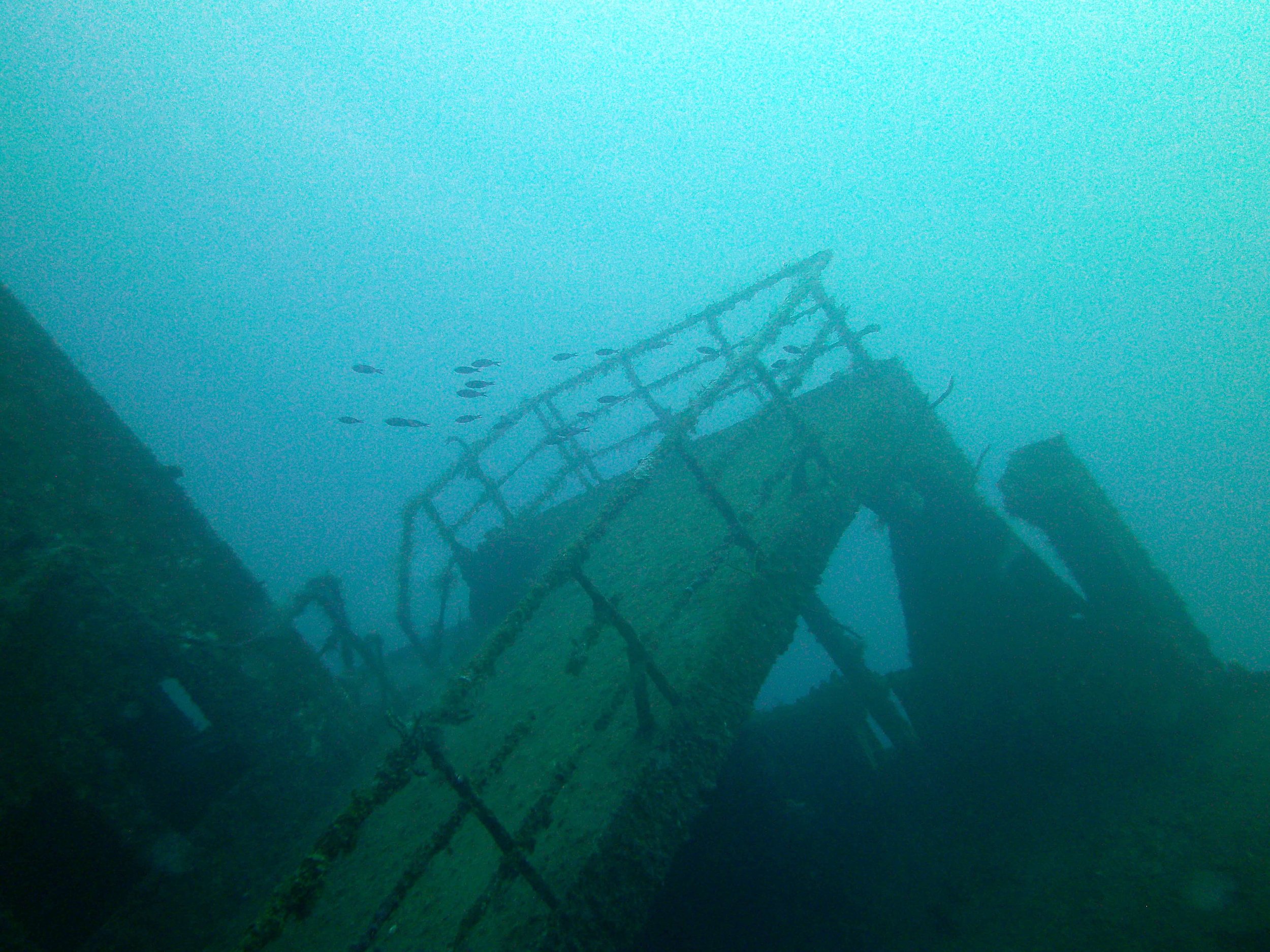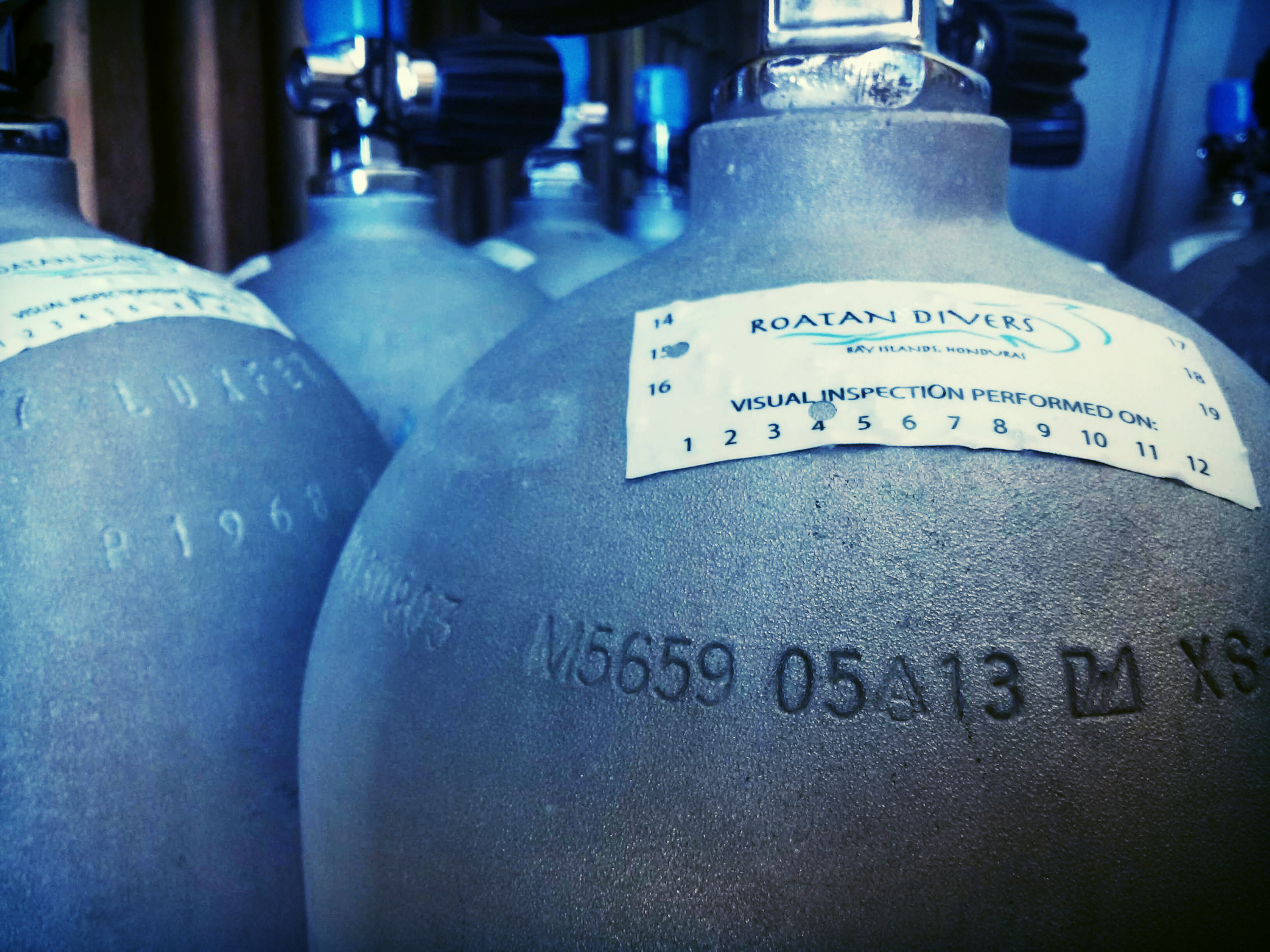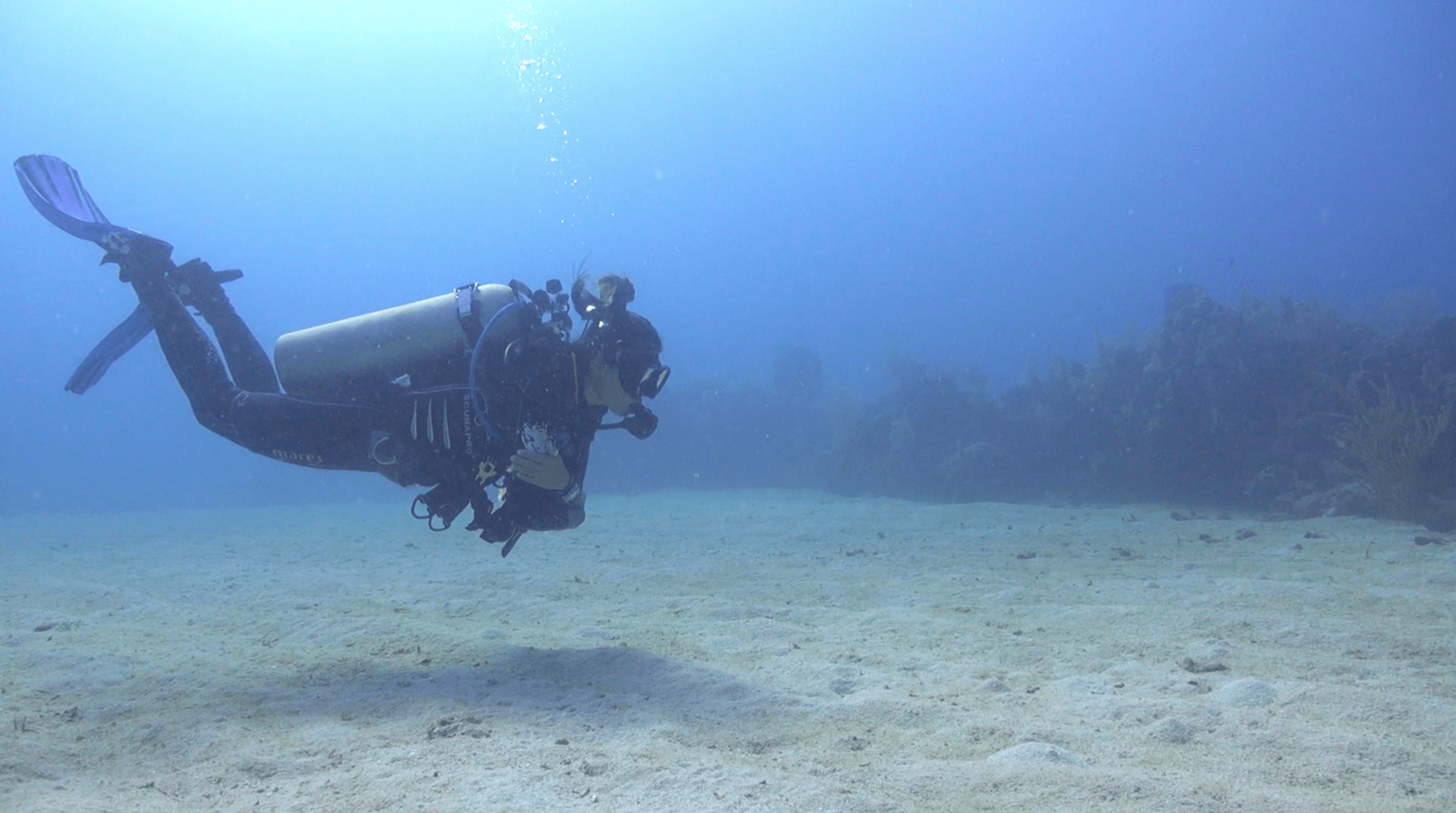Why We Love Mares Dive Equipment
Dive equipment can say a lot about a dive center. When equipment visually looks worn and tattered it might also speak to the care and maintenance that equipment may or may not have received in its lifetime. At Roatan Divers, we replace our rental BCD's every 1 to 2 years, not because we need to, but because we take pride in offering top-notch equipment to our divers. When prospective divers ask to see our equipment, we're always happy to oblige them.
Roatan Divers is a proud Mares Dealer
As a Mares partner and dealer in West End, we are very proud to offer all Mares equipment for our rental gear. Mares is one of the biggest scuba equipment manufacturers in the world, and it's not hard to see why! While they have a reputation for high quality equipment ranging from BCDs to regulators to dry bags, they are most famously known for their masks and fins. The Mares Avanti fins (both full foot and open heel) are considered some of the best fins on the market - there's a reason why most scuba instructors use the Avanti open heel fins! They are durable, strong and last forever. When Roatan Divers first started, we knew without a shadow of a doubt that the Mares Avanti would be our rental fin of choice, regardless of what other brands were available for other rental gear.
Dive equipment can say a lot about a dive center. When equipment visually looks worn and tattered it might also speak to the care and maintenance that equipment may or may not have received in its lifetime. At Roatan Divers, we replace our rental BCD's every 1 to 2 years, not because we need to, but because we take pride in offering top-notch equipment to our divers. When prospective divers ask to see our equipment, we're always happy to oblige them.
Mares Roatan Store in West End
Luckily for us, Mares has a store conveniently located in West End, so we have been able to provide a full range of Mares equipment for rental. The Mares store is fully stocked with a range of masks, fins, exposure wear, BCDs and regulators, so it's easy to find something that will work for you, whether you're a casual snorkeler or an avid diver.
For many of our guests, they love the ability to try one of our Mares masks to find which one might be the best fit for them before purchasing. The prices here are competitive to the prices in the US, and it's nice having a professional to talk to before buying!
Check out Roatan Mares Store's Facebook page to see what deals they're running, as they often have great sales. For more information about some awesome deals we are now able to offer our Divemaster and Instructor candidates through our partnership with Mares, make sure to check our dedicated Divemaster website!
How Being a PADI Rescue Diver Changes You
Being a PADI Rescue diver is about giving you the knowledge and skills to better care for yourself as well as other divers both in and out of the water. Divers describe this course as the most challenging, yet rewarding courses they have ever taken. If you're considering diving in, here's what you need to know about becoming a Rescue Diver.
Being a Rescue Diver is about giving you the knowledge and skills to better care for yourself as well as other divers, both in and out of the water. Divers describe this course as the most challenging, yet rewarding course they have ever taken. If you're considering diving in, here's what you need to know about becoming a PADI Rescue Diver.
It Changes Your Perspective
The PADI Rescue Diver course teaches you how to prevent and manage problems in and out of the water. We teach you how to spot warning signs that a diver might be nervous, unwell or potentially about to panic. This ability to anticipate a risky situation, whether it's from other divers or yourself, is extremely valuable. Now you're aware and engaged in a whole new way when you go diving - and we don't just mean in the water! From being on land, to the boat, to equipment, you now see things from a different perspective. Even your outlook and criteria on how you choose dive centers may be different. Together, all of these elements lead you to going diving with far more freedom and increased capabilities as a PADI Rescue Diver.
It Increases Your Confidence
With this new perspective, expect to feel a new level of confidence as a recreational diver. We teach you how to identify possible scenarios like a tired diver, panicked diver and even a non responsive diver and how you would respond to each accordingly. By learning these skills, you are now equipped with the knowledge to help others, and a greater self-awareness in recognizing your own potential problems. This increase of confidence, and knowing that you can help others if needed, is a priceless feeling you can take with you anytime you go diving.
You Become a Better Buddy
Which divers have you admired? All divers have, at some point, wanted to become a better diver. For many, it's the desire to improve buoyancy or air consumption, but as more experienced divers can tell you, it's all about having a good dive buddy. During this course, you learn to become a better buddy by practicing problem solving skills until they become second nature. Keep in mind, that even when you go fun diving, there will likely be more qualified diving Professionals around you like a PADI Divemaster or Instructor. For those divers interested in becoming a PADI Professional, the Emergency First Response & Rescue course is usually the first step in doing so.
Breaking Down the PADI Rescue Course
Rescue students on a dive with Roatan Divers
The PADI Rescue Diver course takes roughly three to four days.
Through knowledge development and rescue exercises, you learn what to look for and how to respond. These scenarios take place underwater, at the surface, and even extend to the shore. Finally once you have practiced how to handle these scenarios, you will go on two open water dives to reinforce your new knowledge and skills.
One of the most fun elements to the PADI Rescue Diver course is the instructor's ability to get creative in how they test your response time and thought process. The goal is to simulate as closely, but safely as possible, potential rescue situations. The Emergency First Response (EFR) Primary & Secondary Care is a prerequisite along with being a PADI Advanced Open Water Diver or PADI Adventure Diver. As for minimum age, younger divers between 12-14 years old are able to work towards a Junior Rescue certification.
Short on time? If you'd like to cut down on course time to take advantage of your time on the island, consider doing PADI eLearning through us to get all your bookwork done ahead of time so you can dive in right away!
If you're ready to start in on a challenging but fun scuba course that helps change your perspective, increase your confidence and generally makes you a better dive buddy, contact us today to get started!
3 Roatan Sites You Should Dive on Nitrox
Enriched air contains a higher oxygen content and lower nitrogen content air does, giving a diver the ability to extend their no-decompression limit (or dive time). For a few of our dive sites, given their topography and depth, we find it more enjoyable to dive on enriched air Nitrox (EANx32).
One of the many perks of diving on Roatan is the high volume of dive sites available in close proximity to land, with calm conditions and reefs starting shallow so that that we can easily dive on air.
Despite that fact that most of our dive sites are conducive to diving on air, we have a lot of Nitrox certified divers who like to dive on enriched air because of its many benefits. While it all comes down to personal preference, there are a few dive sites here on Roatan that we highly recommend diving on Nitrox in order to enjoy longer bottom times.
Enriched air contains a higher oxygen content and lower nitrogen content air does, giving a diver the ability to extend their no-decompression limit (or dive time). For a few of our dive sites, given their topography and depth, we find it more enjoyable to dive on enriched air Nitrox (EANx32). Having your Enriched Air Diver certification and diving on Nitrox will allow you to explore these sites to their fullest and to ensure a conservative profile.
1. The Odyssey Shipwreck
This cargo ship measures 300ft/100m in length, is about a 20 minute boat ride from West End. Sunk in 2002, the wreck sits on the sand at 110 ft/30.5m, and diving on Nitrox allows you to explore the length and structure of this ship with ample no-decompression time to spare.
For example, according to the NOAA (National Oceanographic and Atmospheric Association) no-decompression dive tables, a diver using Nitrox 36 (or NOAA Nitrox II) may stay up to 50 minutes at 90ft/27m of sea water, while a diver using air may only stay a maximum of 30 minutes at this depth.
2. The Point
This is a top requested dive site from divers and a staff favorite, too! Less than a 10 minute boat ride from West End, this site encompasses the southern point of the island. It is famous for its giant barrel sponges, sea fans, and its nutrient rich water that brings in tons of fish ready to feed. Due to the topography of this site, we like diving it on Nitrox because it allows us to explore the wall, as well as the large plateau area (the area of this site that The Point is famous for) with an average depth of 50ft/15m.
Weather conditions for this site can vary daily, so we like to check the conditions to ensure the wind and potential currents are appropriate to still make it a fun and enjoyable dive!
3. The Seamounts of Cayos Cochinos
The seamounts of Cayos Cochinos lie 18 miles off the point of Roatan and can be reached by special two-tank charter trip (weather permitting), and simply phenomenal when the conditions are right. None of the seamounts break the surface, and the diveable mounts peak between 70ft/21m and 40ft/12m in depth. To get the most bottom time out of each dive, we strongly encourage Nitrox for at least the first dive. The coral at the seamounts is healthy and vibrant, and you have the opportunity to see lots of different schools of fish hanging off the reef as they feed.
Now, just because we recommend Nitrox for these dive sites does not mean you can't dive them on air. We simply think that these sites in particular are more enjoyable when you can spend longer enjoying the deeper topography of these sites!
Not a certified Nitrox diver yet? No worries, it's a fun, easy and enormously beneficial course! The PADI Enriched Air Diver certification can be done in a few hours, so it won't have to take up your entire vacation. Check with your local dive shop or drop us a line, and we would be happy to get you diving on EANx32!
Am I Ready To Do My PADI Advanced Open Water Course?
For many Open Water Divers, the Advanced Open Water course can seem like an elusive or possibly intimidating certification. Do I have what it takes to be an advanced diver, and why should I even take a course like this?
Fear not, diving friends! Let's shed some light on what it takes to complete your PADI Advanced Open Water course.
For many Open Water Divers, the Advanced Open Water course can seem like an elusive or possibly intimidating certification. Do I have what it takes to be an advanced diver, and why should I even take a course like this?
Fear not, diving friends! Let's shed some light on what it takes to complete your PADI Advanced Open Water course. Enthusiasm is not required, but it's a huge plus!
The Advanced course takes a minimum of two days and consists of five PADI Adventure dives.
PADI offers many types of Adventure Dives to choose from. Underwater Navigation and Deep Dive are required, giving you three more Adventure Dives that you can choose. Here at Roatan Divers, the most popular Adventure Dives we teach are the Night Dive, Drift Dive, Underwater Naturalist, and Peak Performance Buoyancy.
Classroom time: For the Advanced course, you complete the Knowledge Reviews for the Adventure Dives you have chosen, then after a thorough briefing from your PADI Instructor, you go on an open water dive to apply what you have learned. Unlike the PADI Open Water Diver course, there are no confined water skills.
Why should I become a PADI Advanced Open Water Diver?
We love getting this question! One of the most common motivators for divers to pursue this certification is their desire to go on more elaborate, adventurous dives! Perhaps a deep dive to the El Aguila ship wreck that sits at 30m/100 feet? Maybe a night dive to catch the magical bioluminescence, or better buoyancy to give you control and confidence to avoid unwanted contact with the reef when looking at smaller marine life.
The very popular Deep and Night Dives can be a bit more complex, so they require additional knowledge and safety aspects to consider. This course allows you to expand your skills and confidence to make you a more well rounded scuba diver.
One of the biggest struggles for new divers is gaining better control their positioning and buoyancy on a dive. The Peak Performance Buoyancy dive is a great opportunity to experiment and challenge yourself in this area. It can even help improve your air consumption along the way!
Common misconceptions
Let's clear up a few of the myths that might be stopping you from starting your PADI Advanced Open Water course.
There is no minimum number of dives required if you're already a PADI Open Water or Junior Open Water Diver.
As a PADI Open Water Diver you are certified to a depth of 18m/60ft, so if you'd like to go deeper, additional training is strongly encouraged.
Open Water divers over 15 years old can participate in ALL of the Adventure Dives that are available in the PADI Advanced Open Water course. After completing the course, they will be certified to dive to a depth of up to 30m/100ft.
Junior Open Water divers over the age of 12 can participate in many of the Adventure Dives as well. After completing the Advanced course they will be certified up to 21m/70ft, which will automatically upgrade to 30m/100ft when they turn 15.
Now that you have a better understanding of what the PADI Advanced Open Water course consists of now, you can talk to your local dive shop if this is the right course for you!
If you're interested in speaking to us or have any additional questions, please contact us today!
Let's Try Scuba Diving!
You love the ocean and enjoy snorkeling. Sometimes, though, you wish you could get a little closer to the reef and all the fish, and you could do with a less less salt water in your snorkel. You've heard that it takes a few days to get your scuba certification, and you're just not sure you're ready to take such a big step. What options do you have?
You love the ocean and enjoy snorkeling. Sometimes, though, you wish you could get a little closer to the reef and all the fish, and you could do with a less less salt water in your snorkel. You've heard that it takes a few days to get your scuba certification, and you're just not sure you're ready to take such a big step. What options do you have?
Have no fear, the PADI Discover Scuba Diving program is here! In the same way that you can take a car out for a test drive before you buy it, you can try out scuba diving before pursuing your certification course. The PADI Discover Scuba Diving program is a half day course that introduces you to the underwater world while also teaching you about equipment and basic underwater safety skills. You get to experience a real dive, like certified divers do, all under the supervision of a PADI instructor to ensure your safety and comfort.
At Roatan Divers, our typical PADI DSD program looks like this:
1. Your instructor explains the essentials of what you need to know about scuba diving, your equipment and some basic scuba skills. You'll also watch a short PADI DSD video to help you visualize your underwater experience.
2. Now it's time to start blowing bubbles! You'll enter shallow water with your instructor for some underwater skills practice. We normally do this in beautiful Half Moon Bay, located right next to the dive center, where you can get comfortable with your scuba diving gear and practice what it will be like diving in open water.
3. You've built up some confidence, and now you're off to do a dive to maximum 12m/40ft in the Caribbean Sea. Your instructor will evaluate the weather and water conditions and select a dive site that's just right for your experience. We have over 30 dive sites within a 10 minute boat ride from the dive shop, so there are a ton of possibilities!
When you embark on your PADI Discover Scuba Diving experience, you will always have your experienced PADI instructor with you to help things go smoothly, and to allow you to have the best experience possible as you dive and explore the healthy, vibrant Mesoamerican reef.
If you enjoyed your PADI Discover Scuba Diving experience and want to dive some more, then let us know and we can arrange additional DSD dives with your instructor! And if you're hooked on diving and are ready to further your skills and education, then the PADI Open Water Diver course is for you. Please contact us if you have any questions or are ready to get started on your scuba diving adventure, and let us help you plan the experience of a lifetime!
5 Surefire Ways to be a Scuba Beauty
Let's face it, scuba diving is not the most glamorous sport. I don't know who decided that sexy was the way to go in all those scuba equipment ads in the magazines, but it is a big fat lie. Mask marks, snot on your face and a saggy wetsuit is what defines a true diver.
Let's face it, scuba diving is not the most glamorous sport. I don't know who decided that sexy was the way to go in all those scuba equipment ads in the magazines, but it is a big fat lie. Mask marks, snot on your face and a saggy wetsuit is what defines a true diver.
There are, however, some ways that we can come out of our dives not looking like the Tasmanian Devil. So ladies, I give you Five Surefire Ways to be a Scuba Beauty!
Tip 1. Keep your hair back with a headband or hoods
There's nothing worse than getting your hair snagged in your mask strap or having it floating all around your face. Headbands are cheap and something you can find anywhere. Preferably go for a thick headband so that it doesn't slide around as much, or there are some headbands specifically designed for swimming and scuba diving that are made from more durable materials, like silicone.
For hairstyles, braids seems to be the best option to avoid your hair from going all over the place. You can do a french braid and not need a headband at all, or use a headband and braid your hair normally.
Another option is to wear a hood. That way, all your hair is contained and you don't have to worry at all! If you're worried about feeling constricted, opt for a thin "beginner" hood instead of a neoprene one.
Tip 2. Soak your hair in fresh water before your dive
Our hair is porous, and that's one of the reasons that salt water wreaks such havoc on your hair, because the salt water soaks in completely. If you soak or rinse your hair in fresh water before you go diving, your hair will be maxed out on what it can absorb, so the salt water won't be able to soak into your hair. It won't prevent of salt water damage completely, but it will certainly limit the damage!
Tip 3. Rinse your hair with fresh water right after you dive
You don't even have to use conditioner, just make sure to rinse your hair with fresh water after you dive. If there are no showers or hoses available after your dive, then you can even use your water bottle as an impromptu shower as well. Rinsing the salt water off as soon as possible will help prevent damage.
On the plus side, salt water in your hair means that your hair will start to bleach, so if you're going for a lighter look, this is certainly an au naturel way to do it!
Tip 4. Waterproof is your friend
I wouldn't advise wearing make-up when you dive because it's all just going to come off, but if you have to wear make-up, please go for waterproof options. Your eyes may look lovely and lined before the dive, but you're just going to end up looking like a panda afterwards.
In general, I would advise against foundation, concealer, blush and lipstick, even if they're waterproof. The foundation will just end up all over your mask, so you'll have a weird, make-up-less circle around your eyes where it's come off, and you'll have more lipstick on your mouthpiece than on your lips.
Tip 5. Don't worry, be happy!
We're all going to have bad hair or skin days, even when we're not diving. We're going to have nights that we didn't get enough sleep, or our noses are runny. It happens.
The best thing about diving is that we're all in the same boat (figuratively speaking). When we're diving, all of us, no matter what, are going to come up with snot all over our faces and salt water in our mouths. Don't worry about how you look, just focus on how you feel and how awesome that dive was and how accomplished you feel. That's the key to making you a true Scuba Beauty!
Tips for Maintaining Scuba Cylinder Health
Out of all your scuba diving equipment, your scuba cylinder is the unsung hero of it all. We have a tendency to focus on the quality and maintenance of the wetsuits, BCDs and regulators of wherever we go diving, but not on the most important feature of your scuba equipment, and your lifeline.
Out of all your scuba diving equipment, your scuba cylinder is the unsung hero of it all. We have a tendency to focus on the quality and maintenance of the wetsuits, BCDs and regulators of wherever we go diving, but not on the most important feature of your scuba equipment, and your lifeline.
Scuba cylinders are filled with filtered, compressed air. The air is taken through the air intake of the compressor and passes through a filtration system, where particles and moisture are filtered out of it. However, even with the proper filtration systems, scuba cylinders still need to be inspected once in a while to ensure that they are in proper working order. The two inspection requirements are the visual inspection and hydrostatic test.
1. Visual inspection
Scuba cylinders should be visually inspected once a year by a qualified visual cylinder inspector. In a visual inspection, we empty the tank, take the valve off the top of the cylinder and take a look inside for corrosion, aluminum alloy build-up and moisture. Whenever you dive somewhere, make sure to check for the visual inspection sticker. If it's not there, ask the dive center when their last visual inspection was.
Always check visual inspections before you dive
2. Hydrostatic testing
Scuba cylinders should normally be tested every two to five years, based on local laws and regulations. In a hydrostatic test, the cylinder is normally filled to 5/3 of its normal fill capacity, and then cylinder walls' flex is tested. Hydrostatic testing is imperative to maintaining the integrity of tanks, and therefore imperative to maintaining your safety. Scuba cylinders will have the last date of hydrostatic testing embedded into them. Most local laws and regulations will not exceed five years for hydrostatic testing requirements, so if the last date of testing was over five years ago, make sure to ask about it.
This tank was hydrostatically tested in May 2013
Here are some tips to help maintain your scuba cylinders:
1. Don't ever empty a tank completely.
Pressure inside the tank prevents water from entering it. Make sure never to empty your tank too quickly either, as that can cause condensation to build up on the inside and outside.
2. Have your tanks filled only by reputable scuba air stations
If a guy is filling scuba tanks out of the back of his van, the air probably isn't going to be super clean. Remember, even minute percentages of contamination, such as carbon monoxide, will be greater under pressure, so you want to make sure your air is clean to prevent such issues.
An analysis certificate from Trace Analytics, based on a quarterly air sample
Air stations should get their air tested, preferably quarterly. We use Trace Analytics, an independent testing lab in Texas. We send them air samples every three months, and they send back the results to let us know if the air passes. Air testing is a great way of also checking on the compressor's health, because if the air doesn't pass, it's a sign that there may be something wrong with the compressor as well.
3. Store your cylinders in a cool, dry place
Extreme heat is the death of scuba cylinders, so avoid putting them under extra pressure and keep them out of the sun. Also make sure to keep them standing in a cool, dry place where they can't get knocked over.
Our scuba cylinders are such an important part of our scuba equipment, so make sure not to neglect them! Remember, maintenance is key when it comes to anything, so keep all of your scuba gear well-maintained and serviced and you will get many years of diving with them.
Happy diving!
5 Smart Ways to Improve your Air Consumption
Good air consumption can open up your world when it comes to scuba diving, so let's discuss 5 smart ways to improve your air consumption.
You're 40 minutes into the most amazing dive in the world, surrounded by beautiful schools of fish and vibrant soft coral moving gently in the currently, when an enormous eagle ray comes gently floating by. You want to stay in this moment forever when...curse! You're at 700 psi. It's time to start your safety stop and end the dive.
Want to avoid these types of scenarios? Good air consumption can open up your world when it comes to scuba diving, so let's discuss 5 smart ways to improve your air consumption.
Instructor Eri demonstrating great buoyancy control.
Tip 1. Take a buoyancy course
Good buoyancy is the key to good air consumption. There are three main benefits of being weighted well and demonstrating good buoyancy: you don't waste a lot of air inflating and deflating your BCD, your breathing is more regulated and you use less energy.
Whenever we have Advanced Open Water Diver students, the first dive of the course that we always strongly recommend they complete is the Peak Performance Buoyancy dive. You learn how to weight yourself properly, how to swim in a good, efficient manner and how to use your lungs, not your BCD, to control your buoyancy. It's a really beneficial dive that improves people's diving for their entire diving careers, so it's a dive that should definitely not be missed.
Want to take it even further? Take an entire buoyancy specialty course, where you spend several dives focusing just on buoyancy. This will greatly improve your diving and your air consumption in the long run.
Tip 2. Be a yogi (or at least breathe like one)
A lot of people find that doing yoga benefits them as scuba divers. Even if you don't do yoga, it doesn't hurt to breathe like someone that does. Yoga breathing is very similar to how you should breathe in scuba diving. Nice, long deep breaths in and nice, long deep breaths out.
Breathing deeply not only improves your air consumption, but it improves your buoyancy control as well. Your lungs act as a secondary buoyancy control device, so breathing shallowly and holding air in your lugs will make you more positively buoyant. If you are positively buoyant on a dive, especially during your safety stop, it can stress you out and make you breathe even more shallow, further increasing your buoyancy. Breathing your air out deeply will help neutralize your buoyancy, so you get the double benefit of better air consumption, buoyancy control and less stress when you breathe deeply.
Tip 3. To take it further, try the 1:2 rule
When I first started diving, I wanted to see just how good I could get my air consumption, so I started a 1:2 rule to see if it made a difference. Breathe in for a certain number of seconds (4 seconds was comfortable for me) and breathe out for twice that period of time (8 seconds out). While it wasn't a type of breathing I would naturally do, focusing so much on my breathing and taking the time to not only breathe in slowly, but to also breathe out slowly, made a difference for my air consumption. Now, I can actually get two 60 minutes dives off of one tank if I am so inclined (I'm not normally so inclined, but it's had its benefits before).
Tip 4. Be efficient
Efficiency is the name of the game in scuba diving. Efficient kicking is important to decrease your energy consumption and breathing. When you're diving, you basically want to be hovering always with a gently kick or two every once in a while. Try not to use your arms as that will increase your energy consumption, and though you may not notice it, your breathing will increase as well. Watching your guide or instructor as they dive and see if they're being efficient. If they are, try to mimic them and see how it suits you! If they're flip-floppiting everywhere, then use them as your example of what not to do.
Tip 5. Be gentle with yourself
Being a good diver does not always come naturally to everyone. Some people are great divers on their first Discover Scuba Diving program. Some people require dozens of dives and lots of additional training before they become good, comfortable divers. Everyone is different. If your air consumption is faster than the others, that's okay. With time and some practice, your air consumption will improve, so give yourself a break and just enjoy yourself. The more stressed you are, the more you will breathe, so just relax and enjoy your dive!
So there you have it, 5 smart ways to improve your air consumption! Remember, the most important part of your scuba diving experience is to be mindful, smart, and most of all, have fun. Everything else will come in time, so enjoy the beautiful underwater world and you'll get a 60 minute dive before you know it!


